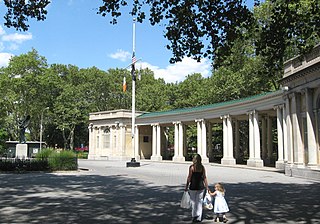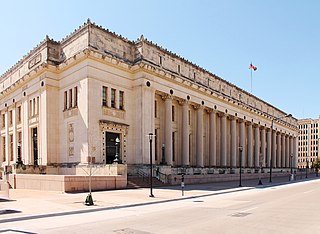
Monsignor McGolrick Park is located in Greenpoint, Brooklyn, in New York City, between Driggs Avenue to the south, Russell Street to the west, Nassau Avenue to the north, and Monitor Street to the east.

Eagle Point Park is a 164-acre (0.66 km2) public park located in the northeast corner of the city of Dubuque, Iowa, United States. Eagle Point is mostly situated on a bluff that overlooks the Mississippi River and the Lock and Dam No. 11. The park is owned and operated by the city of Dubuque. It was listed as a historic district on the National Register of Historic Places in 2017. At the time of its nomination it contained 34 resources, which included 14 contributing buildings, seven contributing sites, five structures, five objects, two non-contributing buildings, and two non-contributing structures.

The Boca Chita Key Historic District is a U.S. historic district within the Biscayne National Park in Miami-Dade County, Homestead, Florida. Located on the northwest section of Boca Chita Key, delimited by Biscayne Bay in the north and west and a half ruined stone wall on its southern side, it contains three historic buildings and the Boca Chita Lighthouse. On 1 August 1997, it was listed in the National Register of Historic Places for its architectural, historical and recreational values.

Crescent Park Looff Carousel, also known as Crescent Park Carousel or more officially as Crescent Park Looff Carousel and Shelter Building, is a National Historic Landmark in East Providence, Rhode Island.

242 Summer Avenue is a historic house located in Reading, Massachusetts. It is locally significant as a well-preserved example of a Shingle style house.

The Pearl Street School is a historic school building at 75 Pearl Street in Reading, Massachusetts. Built in 1939, the two-story brick and limestone building is Reading's only structure built as part of a Public Works Administration project. The site on which it was built was acquired by the town sometime before 1848, and served as its poor farm. With fifteen classrooms, the school replaced three smaller wood-frame schoolhouses in the town's school system, and was its first fire-resistant structure.

The F.W. Woolworth Building is a historic department store building located in Sundance Square section of downtown Fort Worth, Texas. The building served as a retail location for the F. W. Woolworth Company from 1926 to 1990. It now houses other tenants including a JoS. A. Bank Clothiers store.

The Barton House in Salado, Texas was built in 1866. It was listed on the National Register of Historic Places in 1983.

The U.S. Post Office and Courthouse, also known as the Galveston Federal Building, is a post office and courthouse located in Galveston, Texas, United States. The building serves as the federal court for the Galveston Division of the United States District Court for the Southern District of Texas. Constructed in 1937, and added to the National Register of Historic Places in 2001 as Galveston U.S. Post Office, Custom House and Courthouse, the building is home a number of federal agencies, and at one point housed the Galveston Bureau of the National Weather Service.

Hillside, also known as the Charles Schuler House, is a mansion overlooking the Mississippi River on the east side of Davenport, Iowa, United States. It has been individually listed on the National Register of Historic Places since 1982, and on the Davenport Register of Historic Properties since 1992. In 1984 it was included as a contributing property in the Prospect Park Historic District.

Confederate Reunion Grounds is a Texas historic site located near Mexia, Limestone County, Texas at the confluence of the Navasota River and Jack's Creek. From 1889–1946, Confederate Civil War veterans and families reunited at the site during late-July or early-August, camping under the giant bur oaks, enjoying speeches, concerts, dances, fellowship and food, and raising funds for families of their fallen comrades.

Wharton–Scott House, also known as Thistle Hill, is a historic mansion in Fort Worth, Texas.

Pollock–Capps House is located on 1320 Penn Street in Fort Worth, Texas, next door to the Eddleman-McFarland House. The Queen Anne Victorian style home, located atop a bluff overlooking the Trinity River, was possibly designed by Howard Messer, architect of the Eddleman-McFarland House, and was named after Joseph Robert Pollock, a physician who moved to Fort Worth in 1887. Pollack and his wife Phoebe sold the house to William and Sallie Capps in 1910. William Capps was a distinguished lawyer while his wife Sallie was president of the Fort Worth Kindergarten Association and a Regent at the College of Industrial Arts in Denton. Historic Fort Worth Inc. purchased the house in 1971. Three years later the organization sold the house to Architect Robert W. Chambers.

Acequia Madre de Valero is an 18th-century agricultural irrigation canal built by the Spanish and located in the Bexar County city of San Antonio in the U.S. state of Texas. When Martín de Alarcón founded San Antonio for Spain by establishing San Antonio de Valero Mission in 1718, Franciscan priest Antonio de Olivares and the Payaya and Pastia peoples, dug Acequia Madre de Valero by hand. It was vital to the missions to be able to divert and control water from the San Antonio River, in order to grow crops and to supply water to the people in the area. This particular acequia was the beginning of a much wider irrigation system. Acequia Madre de Valero ran from the area currently known as Brackenridge Park southward to what is now Hemisfair and South Alamo Street. Part of it that is not viewable by the public runs beneath the Menger Hotel. The acequia was restored in 1968 and that same year was designated a Recorded Texas Historic Landmark.

This is a list of the National Register of Historic Places listings in Limestone County, Texas.

The Farrington House is a historic house at 30 South Main Street in Concord, New Hampshire. Built in 1844 as a duplex, it is a distinctive local example of high-style Greek Revival architecture. It was listed on the National Register of Historic Places in 1982.

United States Post Office is located on 251 W. Lancaster Avenue in Fort Worth, Texas. Designed by Wyatt C. Hedrick, the building opened on February 22, 1933. Composed of Cordova limestone, the three-story rectangular building was designed in the Beaux Arts style. In 2014, the building was placed on the "Most Endangered Places" list by Historic Fort Worth, Inc. The building was added to the National Register 1985.

The Chautauqua Auditorium is a performance hall located in Getzendaner Memorial Park, in Waxahachie, Texas. It was built in 1902 and listed on the National Register of Historic Places on May 3, 1974. The hall seats 2500 and is noted for being an octagonal building. The auditorium hosts performances of the Fort Worth Symphony Orchestra as well as many country music and other shows.

Lacey-Keosauqua State Park is located southwest of Keosauqua, Iowa, United States. The park is located along the Des Moines River in Van Buren County. First dedicated in 1921, it is the largest state park in size in Iowa. In 1990, three areas were named nationally recognized historic districts and listed on the National Register of Historic Places.

The Stevenson House, is a historic two-story Spanish Colonial style building located at 530 Houston Street in Monterey, California. It was a boarding house called the French Hotel, built circa 1836. The Scottish author Robert Louis Stevenson lived there in 1879, writing and courting his future wife. It is now a museum and property of the Monterey State Historic Park. The building was listed on the National Register of Historic Places on January 7, 1972. The building is also listed as a California historical landmark #352.
























